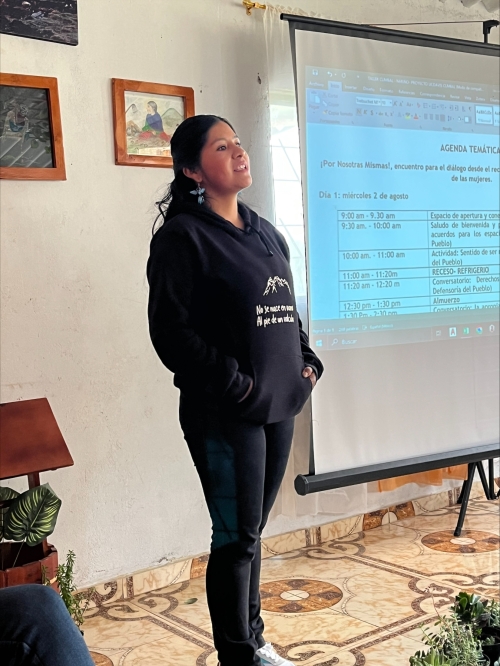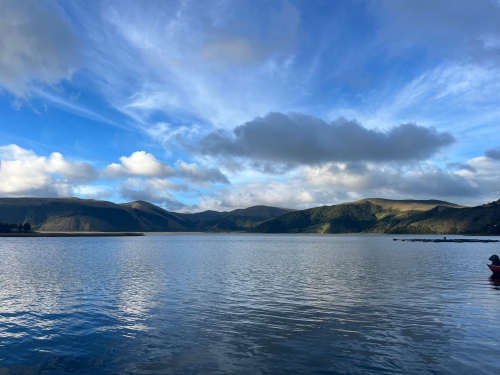#Mujeres Resueltas

By Raquel E. Aldana, Martin Luther King Jr. Professor of Law and Co-Director of the Aoki Center for Critical Race and Nation Studies
I first learned of the hashtag Mujeres Resueltas –"Resolved Women” in English – when the younger generation of Pasto women from the Cumbal and Guachucal communities of the Department of Nariño of Colombia premiered a video they only recently finished containing the oral histories of several of their women. Among the featured oral histories was that of Liliana, a young anthropologist and the host of our convening, and one of the authors of a book I had purchased days earlier titled Mujeres Pastos En la Lucha por la Recuperación de Tierras: Resguardos de Guachucal y Cumbal – Pasto Women in the Fight to Recover Their Lands: the Cumbal and Guachucal Communities – published in 2020.
Two days prior, a small delegation of six that included Kari Peterson, a 2023 King Hall graduate, ABA ROLI Colombia staff, and the Colombian local Human Rights Ombudsman (Defensoría del Pueblo) were greeted at Liliana’s home after a 3-hour windy trek up the Andean mountains of Colombia. By the time we arrived, multiple generations of around twenty Pasto indigenous women had gathered in a room featuring an altar with plants, fruits and vegetables, and incense. Within a span of three days, in oral histories told around the altar, we would come to realize that “las mayoras” among us – “the elder women” – a translation that fails to capture their regal stature [1] – had been the very ones who came down the mountains nearly five decades earlier to reclaim the land stolen from their ancestors centuries earlier. Their acts of resistance combined bold physical incursions down from the mountains to which they had been forcibly displaced into their ancestral homes with legal challenges that relied on colonial titles to establish their collective property rights over the usurping occupiers. The strategy worked. By the time we arrived, these women had been back in their land since the late 1970s.
This decades-old story shook the foundation of what I thought I would encounter in Colombia. We were there with a grant from a UC Davis SDG grant with a focus on rural women land justice in Colombia. After more than five decades of war, Colombia had finally reached a peace agreement in 2016 with some but not all of the actors in the conflict –namely the Revolutionary Armed Forces of Colombia, by far the largest armed group embroiled in the conflict. A significant component of peace involved commitments for rural land reform and rural development born from a recognition of land conflict as a historical root cause of violent conflict in the country. Colombia, one of the few Latin American nations that never instituted land reform, exhibits stark gaps in land ownership among rural landholders. A recent land survey found that 0.2 percent of producers own estates or more than 1000 hectares, which combined encompass nearly a third of the country’s farmland. But in 2021, five years post the negotiation of peace, the assessment of progress on all fronts, including the issue of land, remained bleak. Unfortunately, this did not surprise me. Grounded in my own experiences with nation-building efforts post conflict in Guatemala, I had traveled to Colombia in 2017 to forewarn Colombian civil society that their long-awaited negotiated peace necessitated sustained and resilient engagement, likely over decades, to achieve fruition. Indeed, in anticipation my expectations, I arrived this time in Colombia to share with the Pasto women a story of resistance from the women of La Puya in defense of their territory in Guatemala, this time against multinational metal mining. [2] It was, for me, amazing to witness a what an multigenerational project of rebuilding nation looked like for a community of indigenous women five decades in the making. One story of this evolution stands out for me. In the same space with las mayoras, we spent time with the younger generation – and collectively they called themselves Renacientes (reborn). This newer generation – which included anthropologists, spiritual leaders, homemakers, mothers, political scientist, and political candidates – was tech savvy and informed. Their project involved preserving memory and culture in order to reclaim feminist power in their present.

Recently, I listened to a podcast by an amazing Colombian historian by the name of Diana Uribe who narrates peace stories, including Colombia’s peace, with the magic and beauty of Colombianisms. Uribe reminded me that peace actually is a living process that predates any signed agreement and that remains alive well past its anniversary. In the podcast, Uribe reminded me of the role that women and, indigenous and afro-Colombian women in particular, have been playing for decades to assert peace in Colombia. For the Pasto women, their land was key to center them in this project of reimagining nation. I was struck by the peaceful beauty of the land. During out visit, we visited a pristine lake surrounded by volcanoes where you could breathe pure air and peace.

I am not romanticizing the Pasto women’s story. During our visit, we learned of ongoing fighting in the Nariño region and of the economic struggles on rural agrarian communities who depended on coca production left destitute in a global market that has moved on to fentanyl. More locally, the women complained that the market prize of potatoes and milk, which were their main source of production, could not compensate for their long-hours of daily hard labor or give them enough to eat. They dreamed of one day setting up their own milk production plant to produce their own cheese and other milk products that could displace the exploitative middleman. And while they were grateful that, unlike the women of La Puya, they did not struggle with outside mining activities in the region, they expressed concern that their male-only political indigenous entity had sold carbon credits to a multinational without prior and informed consent from the community as required by ILO Convention 169.
And yet, the closing ceremony with these women perhaps is worth recounting here. Each of us picked up a plant from the altar, our favorite one. We also picked a word that we felt spoke of our story. While we gathered in a circle, our task was to gift our plant and our word to one another in a public ceremony of collective empowerment. My word was the “armadillo,” or Huech, my Mayan Nahual or spirit animal. That is the word that came to me. When I was first told my Mayan spirit animal was an armadillo during a visit to a sacred Mayan site in Guatemala, I was disappointed, especially after my son was told his was the beautiful hummingbird and my spouse the mighty jaguar. But you see the Huech is known as the protector of their community and for their wisdom. I chose a young Pasto woman, Cathy, to whom to gift my plant and my word. I told Cathy, who was one of the creative geniuses behind the oral histories of Pasto women on Youtube, that she was the Huech not only of her community but for all the women of the world.
________________________
[1] In Spanish, the word “mayores” can refer to someone older. However, its meaning is also to be greater than. Moreover, in indigenous communities, mayores is also used to refer to the community’s leaders, who tend to be wiser in age and valued as such.
[2] The Indispensable Ones: A Story of Resistance from La Puya in From Extraction to Emancipation, Development Reimagined (edited collection, with Steve Bender) (Carolina Academic Press and American Bar Association 2018).
